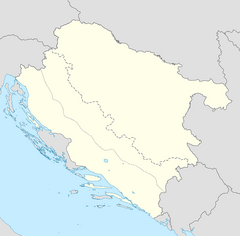
Back KZ Sisak German Camp de concentration de Sisak French Campo di concentramento di Sisak Italian Sisak kinderconcentratiekamp Dutch Koncentracijski logor Sisak Serbo-Croatian Дечји логор у Сиску Serbian
| Sisak | |
|---|---|
| Concentration and transit camp | |
Location of Sisak in the Independent State of Croatia | |
| Location | Sisak, Independent State of Croatia |
| Operated by | |
| Original use | Recreation centre, saltworks and primary school |
| Operational | 1941–1945 |
| Inmates | |
| Number of inmates | 6,693–7,000 (Sisak II) |
| Killed | 1,160–1,600 (Sisak II) |
| Notable inmates | Milja Toroman |
Sisak was a World War II concentration and transit camp located in the town of the same name in the Axis puppet state known as the Independent State of Croatia (NDH). It was operational between 1941 and 1945.
The camp consisted of two sub-camps, Sisak I and Sisak II. The former was used to intern adults destined for forced labour in the Reich and was established in 1941, while the latter was used to detain unaccompanied Serb—and to a lesser extent, Jewish and Roma—children who had been separated from their parents over the course of the conflict. Sisak I was operated by the Germans, whereas Sisak II was administered by the Ustaše, with some German gendarmes guarding its perimeter. The latter became operational in July–August 1942, receiving a group of children who had previously been detained at Mlaka.
Living conditions at the children's camp were poor, leading to a high mortality rate. According to survivors, some children were killed by being given poisoned milk or gruel laced with caustic soda. On other occasions, camp commander Antun Najžer administered children with lethal injections. Thousands of children were saved from the camp as a result of rescue efforts spearheaded by the humanitarian Diana Budisavljević and the local communist underground. Sisak II was dissolved in January 1943. The exact number of children who perished there is unknown, but estimates range from 1,160 to 1,600, largely as a result of starvation, thirst, typhus and neglect. In April 1944, the Germans ceded control of Sisak I to the Ustaše. It was shut down in January 1945 and its remaining inmates were dispatched to Jasenovac.
In September 1946, Najžer was convicted for his involvement in the atrocities that took place at the children's camp and sentenced to death by firing squad. Memorials commemorating the camp victims were demolished in the early 1990s, during the Croatian War of Independence. Camp survivor Gabrijela Kolar's sculpture was spared, but has since fallen into a state of disrepair. In post-independence Croatia, the camp's main building was transformed into a movie theatre and renamed the Crystal Cube of Cheerfulness.
© MMXXIII Rich X Search. We shall prevail. All rights reserved. Rich X Search
